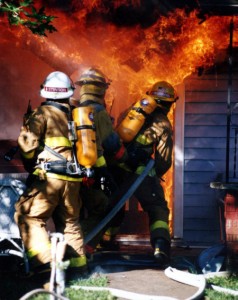This is a guest post by By Captain Craig Nielsen, Los Angeles Fire Department
As a 28-year veteran of the fire service, I’ve been involved in flashover survival trainings since 1998, and I’m seeing more and more occurrences of this phenomenon than ever before. Walton and Thomas define a flashover as “the transition from a growing fire to a fully developed fire in which all combustible items in the compartment are involved in fire” although a more simple definition is “the stage when contents and gases are heated to their ignition temperatures and flames break out almost all at once.” As the number of flashover occurrences increase significantly, so do the number of injuries and deaths.
That’s a big reason why I’m hosting a free “Understanding Flashovers” webinar sponsored by Draeger Safety, on November 10, 2011 at 8 PM EST. Firefighters and chiefs interested in participating in this educational session can register at http://draegerfiresafety.com. We’ll also have a live Q&A so your specific questions can be addressed. For now, I’ll cover some of the key questions firefighters are asking.
Why Are So Many Flashovers Occurring?
The increasing occurrence of flashovers has been covered at great length in print, online and broadcast media and it certainly deserves attention. Here are some reasons for the uptick of flashovers:
- Better turnouts. Firefighters are putting themselves in harm’s way unknowingly because firefighters are so well encapsulated.
- Better insulation: Homes are better insulated which is great for the heating bill, but not so great for firefighters. Thermal feedback will occur more rapidly.
- Combustible items: Plastics and synthetics will create a lot more BTUs. Know what you’re going into and look for signs outside of the building, and you will increase your preparedness for what you’ll encounter inside.
What Are The Warning Signs of Flashover?

Flashover. Attempting entry. Bowling Green, Kentucky. Photo by: Wales Hunter/Code-Red source: FireNuggets.com
Flashovers have signs and symptoms and knowing what they are can help you act appropriately and in the safest way possible. The warning signs can typically be seen and identified, such as:
- Heat build-up. When the fire is low in intensity and spreading slowly, combustibles and flammable gases are heated to the point of ignition.
- No visibility. You can go into a structure and see from one end to the other, not knowing accumulated gas in the ceiling space above may be ready to ignite.
- Rollovers. These are the preemptive signs that a flashover is going to occur. If you witness rollover, cool down those gases effectively and get out of the building.
- Pressurized smoke. If you are observing smoke exiting the exterior of a structure, look for what kind of pressure buildup is associated with that smoke.
What Can I Do To Be Safe?
Safety is always a priority. Here are a few steps to be safe in a flashover:
- Two in – Two out. Flashover can cause disorientation and panic. Work in teams.
- Secondary means of egress. Determine another way out before you even go in.
- Facepipe and full PPEs. This is the best protection for any firefighter.
- Risk vs. Gain. Establish what you’re risking going into the structure and if it is worth putting yourself in harm’s way by going in.
With flashover occurrences increasing, knowing the warning signs is crucial for all chiefs and firefighters, to avoid injury or death. Don’t forget to join me on November 10 for more information.
About the Author
Craig Nielsen, a 28-year veteran of the fire services, is a Captain with the Los Angeles Fire Dept. He has served as a Live Fire Training Officer, Driver Training Instructor, Career Guidance Counselor & Instructor of Record. Nielsen has been assigned to the most active fire station in the country for over two years, with 20+ responses per day. He is a California state-certified Fire Instructor and Fire Officer, and Emergency Medical Technician. He has been a Dräger Swede Survival instructor since 1998.
 Fire Critic An Unadulterated View of the Fire Service
Fire Critic An Unadulterated View of the Fire Service




